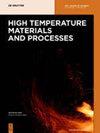Study on diffusion kinetics of chromium and nickel electrochemical co-deposition in a NaCl–KCl–NaF–Cr2O3–NiO molten salt
IF 1.5
4区 材料科学
Q4 MATERIALS SCIENCE, MULTIDISCIPLINARY
引用次数: 0
Abstract
Abstract The process of preparing surface composite by molten salt co-deposition is the result of the mass transfer of active particles in molten salt, electrochemical reduction, and solid diffusion. In this study, we prepared Cr–Ni alloy/low-carbon steel surface composites in NaCl, KCl, NaF, Cr2O3, and NiO melt salt system successfully, and analyzed the entire diffusion dynamics process, aiming to find out the limiting links and provide ideas for further improving the preparation efficiency. The results show that chromium and nickel ions are simultaneously reduced on the cathode surface through two and one steps, respectively. And an alloy layer with Fe content of 64.52 wt%, Ni content of 28.96 wt%, and Cr content of 6.52 wt% is formed on the surface of low-carbon steel substrate. The average diffusion coefficients of chromium and nickel atoms in the surface composites are 1.16 × 10−14 and 1.44 × 10−14 m2·s−1. The mass transfer process in molten salt is the limiting link in the whole preparation process.铬和镍在NaCl–KCl–NaF–Cr2O3–NiO熔盐中电化学共沉积的扩散动力学研究
摘要熔盐共沉积制备表面复合材料的过程是活性颗粒在熔盐中传质、电化学还原和固体扩散的结果。在本研究中,我们在NaCl、KCl、NaF、Cr2O3和NiO熔盐体系中成功制备了Cr–Ni合金/低碳钢表面复合材料,并分析了整个扩散动力学过程,旨在找出限制环节,为进一步提高制备效率提供思路。结果表明,铬离子和镍离子分别通过两步和一步在阴极表面同时还原。以及Fe含量为64.52的合金层 wt%,Ni含量为28.96 wt%,Cr含量为6.52 在低碳钢基材的表面上形成wt%。铬和镍原子在表面复合材料中的平均扩散系数分别为1.16×10-14和1.44×10-14 m2·s−1.熔盐中的传质过程是整个制备过程中的限制环节。
本文章由计算机程序翻译,如有差异,请以英文原文为准。
求助全文
约1分钟内获得全文
求助全文
来源期刊

High Temperature Materials and Processes
工程技术-材料科学:综合
CiteScore
2.50
自引率
0.00%
发文量
42
审稿时长
3.9 months
期刊介绍:
High Temperature Materials and Processes offers an international publication forum for new ideas, insights and results related to high-temperature materials and processes in science and technology. The journal publishes original research papers and short communications addressing topics at the forefront of high-temperature materials research including processing of various materials at high temperatures. Occasionally, reviews of a specific topic are included. The journal also publishes special issues featuring ongoing research programs as well as symposia of high-temperature materials and processes, and other related research activities.
Emphasis is placed on the multi-disciplinary nature of high-temperature materials and processes for various materials in a variety of states. Such a nature of the journal will help readers who wish to become acquainted with related subjects by obtaining information of various aspects of high-temperature materials research. The increasing spread of information on these subjects will also help to shed light on relevant topics of high-temperature materials and processes outside of readers’ own core specialties.
 求助内容:
求助内容: 应助结果提醒方式:
应助结果提醒方式:


